Today I want to talk at length about the legendary supertype. While this article builds on my Tumblr from two years ago, Rhystic Studies’ look at the Legend Rule also motivated me to reexamine the topic and improve on what I had originally done. There’s a lot of history to cover, so let’s get to it.
Legendary creatures as we know them date back to one of the earliest expansions of Magic, the set Legends from June of 1994. This set was designed mostly before the official release of Magic. The designers, in need of something base the set around, turned to their D&D campaigns for inspiration. They reasoned out that if their campaigns had significant people—i.e. their characters—maybe Magic could have them too. And legendary creatures were born. To highlight these characters the choice was made to make their characters even more noticeable by having them exist across more than one color of mana, thus creating as Magic’s first multicolored cards.
Under the initial rules, you could only having one copy of legendary permanent in your deck—capturing the flavor and power of these cards. Additionally, on the battlefield, Magic’s rules stated that only one could exist at a time. At first it kept only the oldest copy in play; meaning that if I cast my copy of Hunding Gjornersen first, your future copy would die as soon as it reached the battlefield.
While the original legendary rules were flawed and oppressive, their addition to Magic canon was hugely important. I am biased though, as I participate in a format made possible by the Legendary mechanic. Much like planeswalker later on, legends were a popular concept that Magic struggled to execute well for many years. We wouldn’t see more legends until Ice Age, in June of 1995.
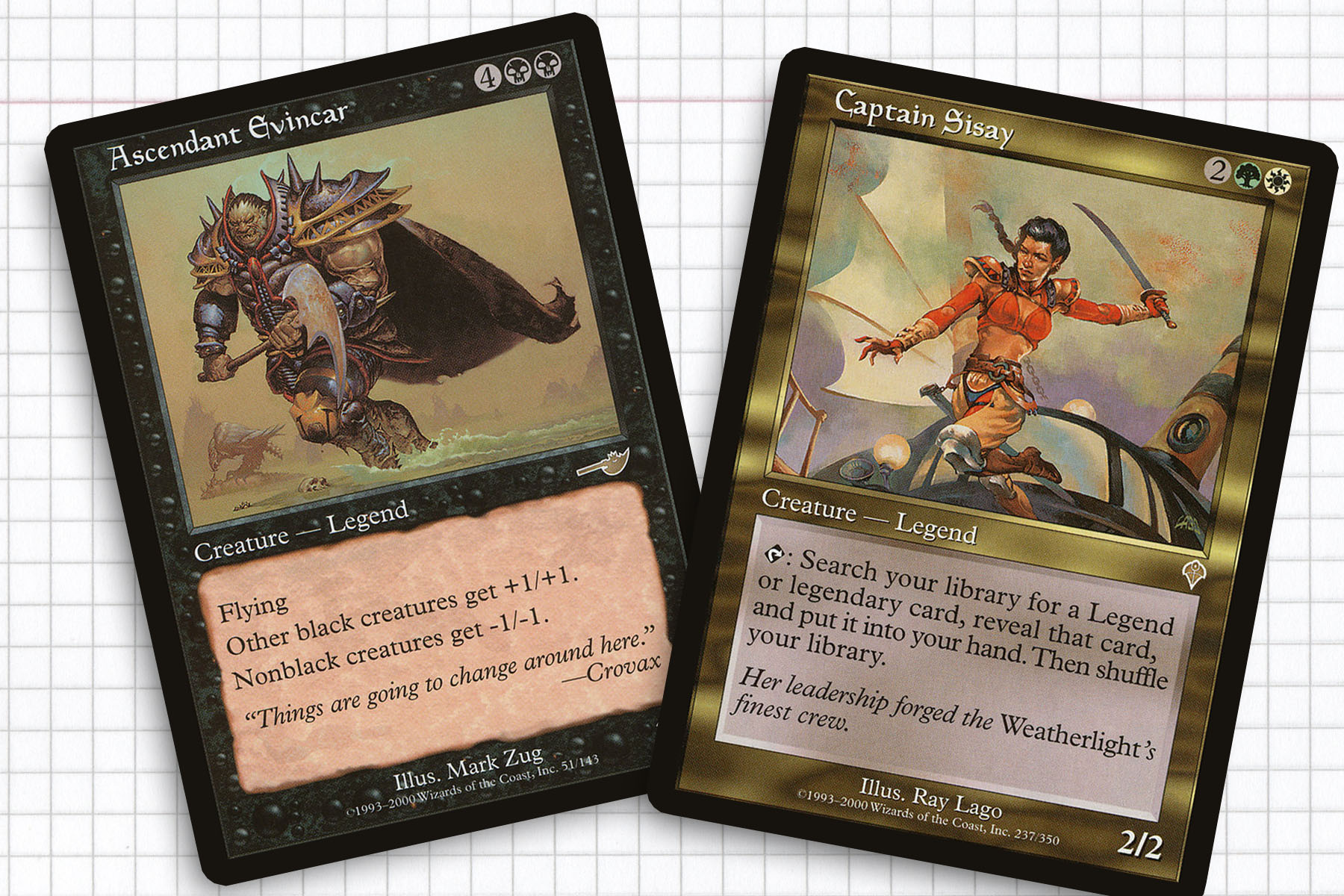
Introducing Story
Legendary creatures (legends) are fabled people existing in the worlds we visit, but the first ones had no larger relevance to the game. With the release of Weatherlight and Tempest in 1997, the cards began to take center stage. This meant the legends began showcasing the characters of the ongoing story. Suddenly, our heroes and villains had a place in the game in the form of Mirri, Cat Warrior, Crovax the Cursed, and Commander Greven il-Vec. We could follow their adventures through the cards in the set and see them in action on the battlefield. While it would be a few more years before the term would be coined, I believe this was the beginning of Vorthos in Magic.
The story that began in Weatherlight ran through the next four blocks and culminated in the final set of the Invasion block, Apocalypse. Throughout all of this, legends like Captain Sisay, Karn, Silver Golem, and Gerrard Capashen were featured on cards to help showcase their place in the story. My one complaint during this era was that aside from a few characters like Ertai and Crovax, we never saw more than one appearance.
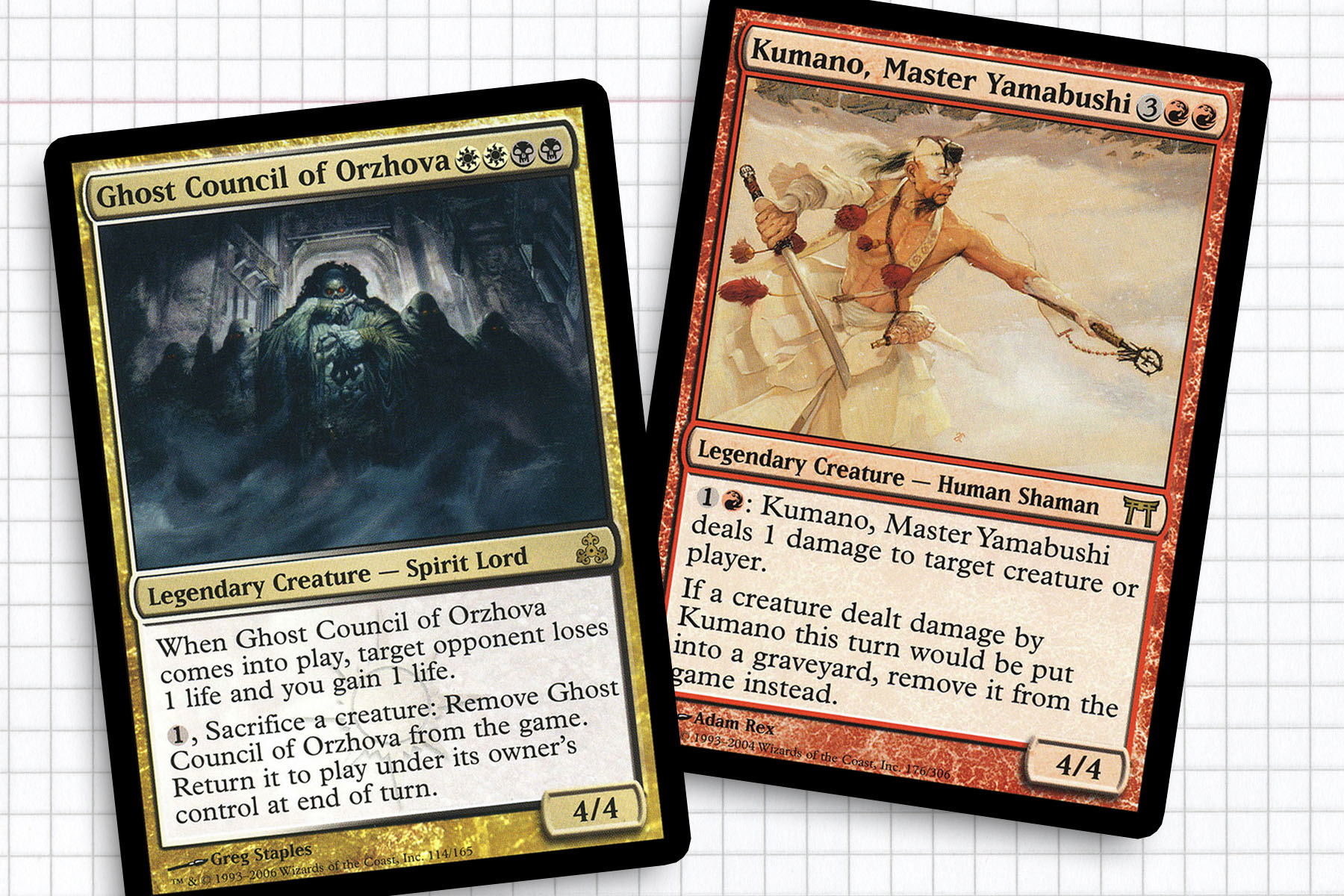
Everyone is Legendary
Around the tail end of 2004, Magic took a trip to the new plane of Kamigawa. The Japanese Shinto-inspired world was home to an ill-received block, whose only crime was putting Creative before Design during worldbuilding. Samurai enthusiasts must forever pay the price. Kamigawa also rewrote the Legend Rule, so that legendary permanents of the same name would destroy each other outright. The new rule created design space for cards like Mirror Gallery and Sakashima the Impostor to explore.
Kamigawa block was designed to highlight legendary permanents in mass, with 147 cards carrying the supertype. Suddenly everything was legendary, including the enchantments, lands, and (sort of) the spells. I personally loved this influx of legends as my Commander career has had me diving back into the block. The major setback of Kamigawa block was that everything was almost entirely mono-colored, meaning we were never given allied or enemy paired legends for tribes used such as Samurai, Ninja, Foxes, or Rats. I still love the block’s concept, even if for a time it lessened the specialness of being legendary.
Thankfully, the original Ravnica block was released the following year. This was an important block in Magic history, because it gave an identity to each of the two-color pairs in a way that had been ill-defined since they were first toyed with in Legends and later Invasion block. Ravnica block again featured legendary creatures, this time in a more structured allied/enemy paired layout. From a lore prospective, this era of legends were a mixed bag of some being important to the stories being told in the novels and others going completely unmentioned.
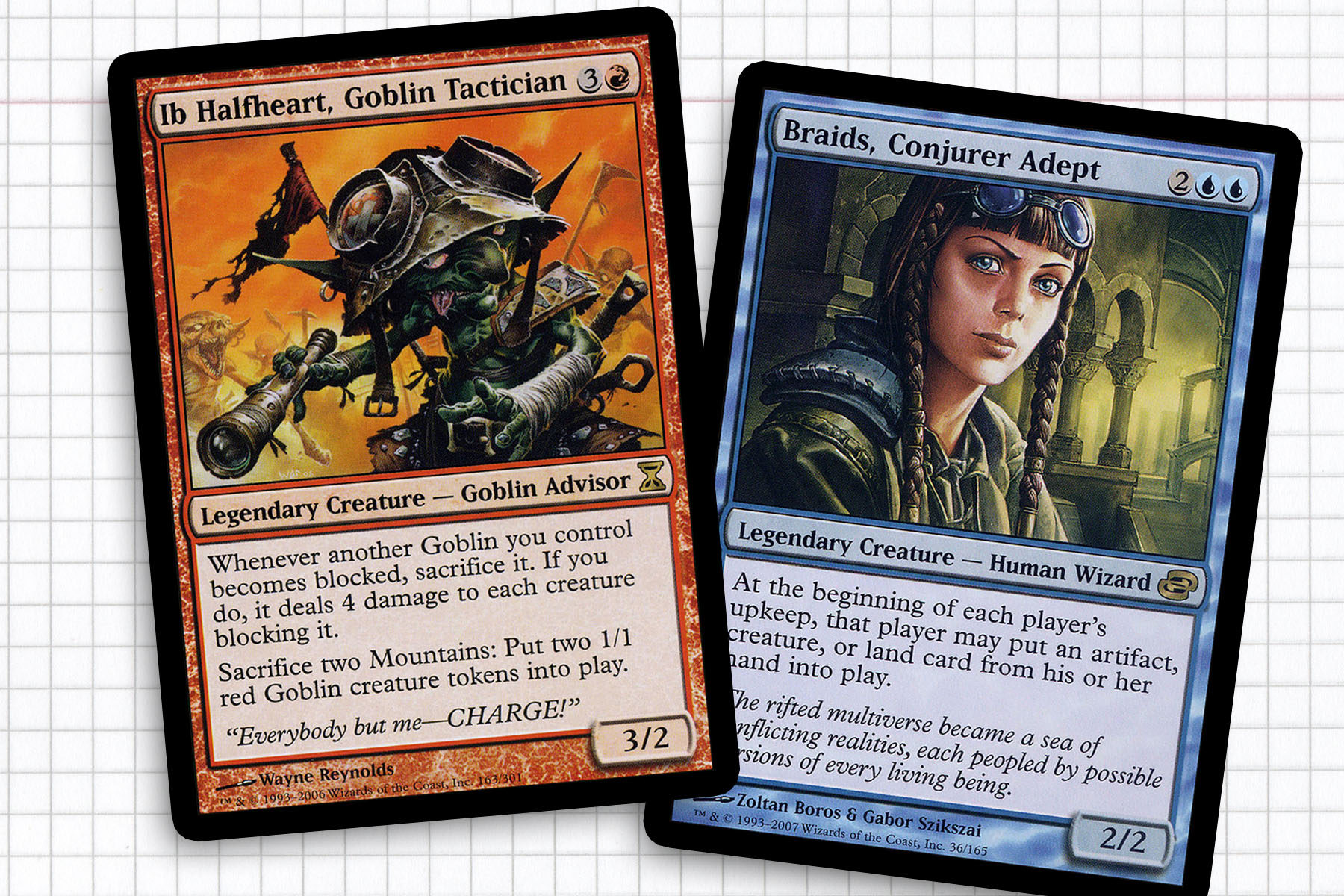
Displaced Heroes
Time Spiral could be described as a nostalgia block. Occupying the space that I see Commander products slowly embracing more and more each year, the designers turned their attentions to defining the characters of early Magic in card form. These appearances highlighted legends as fleeting as Saffi Eriksdotter, appearing in flavor text of one card, all the way up to Jhoira of the Ghitu, who has played a larger role in sets from Urza block to current day. Thankfully we were not restricted to mono-colored creatures this time around.
This was another stage of design that I think had its ups and downs. Part of the nostalgia also meant making the creatures feel like cards from their respective ages of design. In some cases this made for really interesting designs, like Ib Halfheart, Goblin Tactician or Endrek Sahr, Master Breeder. But then there were batches of confusing designs, meant more as in-jokes than meaningful designs, like Mangara of Corondor, Tivadar of Thorn, or Norin the Wary.
I don’t look back as fondly on this time as I might Kamigawa or Ravnica, though I once again appreciate the nonlinear designs with some hindsight. And while I would more than love another Time Spiral block with my entire decade of further knowledge of Magic lore, I think the designs being put forth through Commander products—and hopefully Modern Horizons—do a much better job of addressing characters beloved by longtime fans.
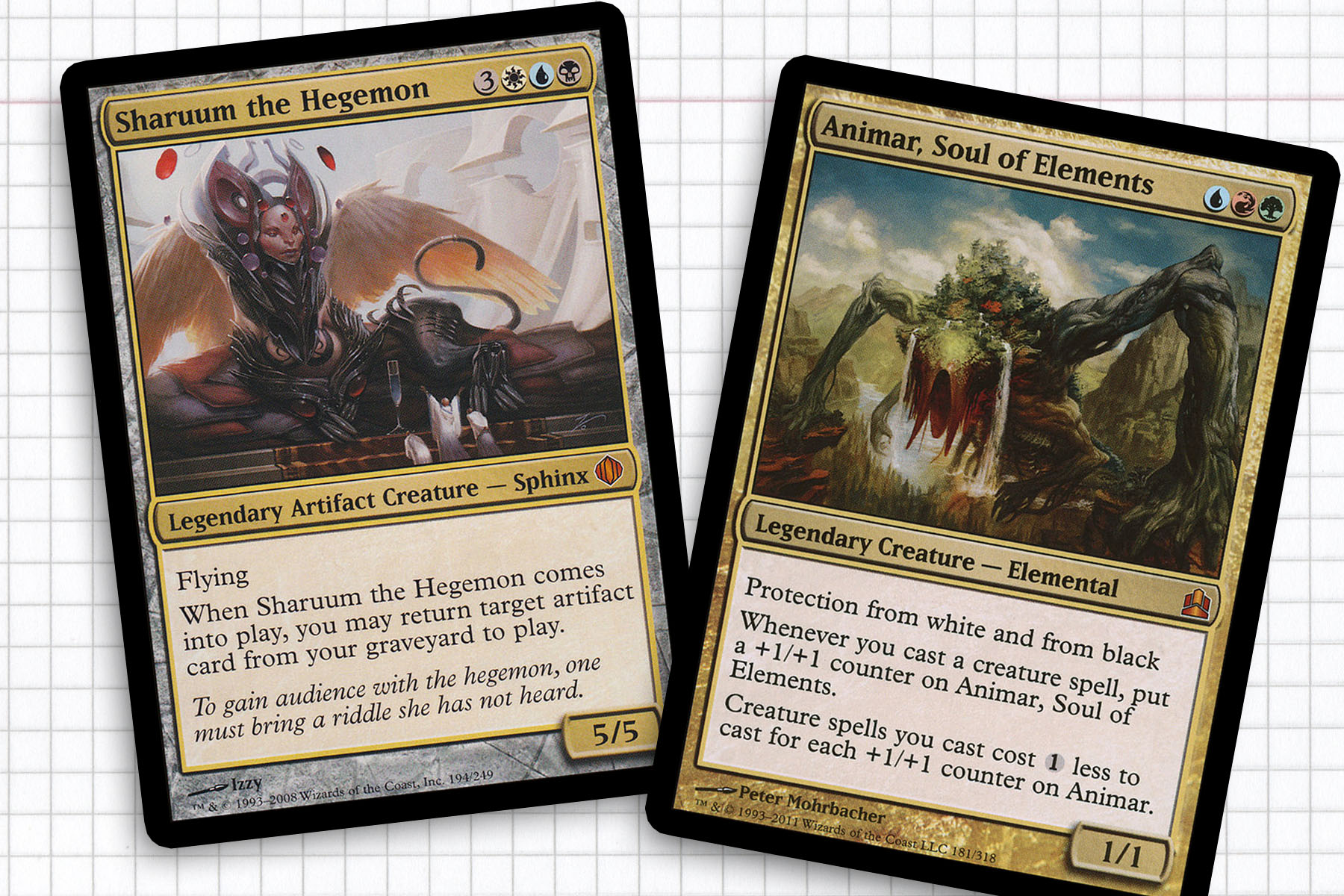
The Rise of Commander
Now we’ve reached Magic circa 2008 and the rise of Commander, especially in the minds of the game’s designers. In my eyes, this explosion in popularity within the community came from the release of Shards of Alara and the heavy influx of shard colored legends, many of which were also well suited for themed decks and underexplored archetypes. This reached its first crescendo with the release of Magic the Gathering: Commander in 2011, giving us wedge colored cards and taking the total number from a handful to double digits.
As the 100-card singleton format began to take root in the general Magic community, the use of legends evolved and their significance began to ramp up. Suddenly, the state of being legendary wasn’t so much a limitation to the playability of a card, and the colors that legendary creatures occupied became a huge deal for the playability of entire archetypes.
Commander products became yearly in 2013, and we also saw changes to Legend Rule around this time with Core 2014 and Theros. Now legendary cards only exploded if they occupied the same side of the battlefield, pushing function over flavor as Rhystic Studies would later point out. But I think this era is most characterized by Wizards starting to consciously design cards for the format, such as Ken Nagle designing Wrexial, the Risen Deep for the purpose of having a general to help combat players who used a lot of Time Walk and Time Stretch effects within their deck. This is a design philosophy that I stand on the fence of: being a fan of the older designs that could be open ended, but understanding that The Age of Commander has existed for almost half the lifetime of the game.
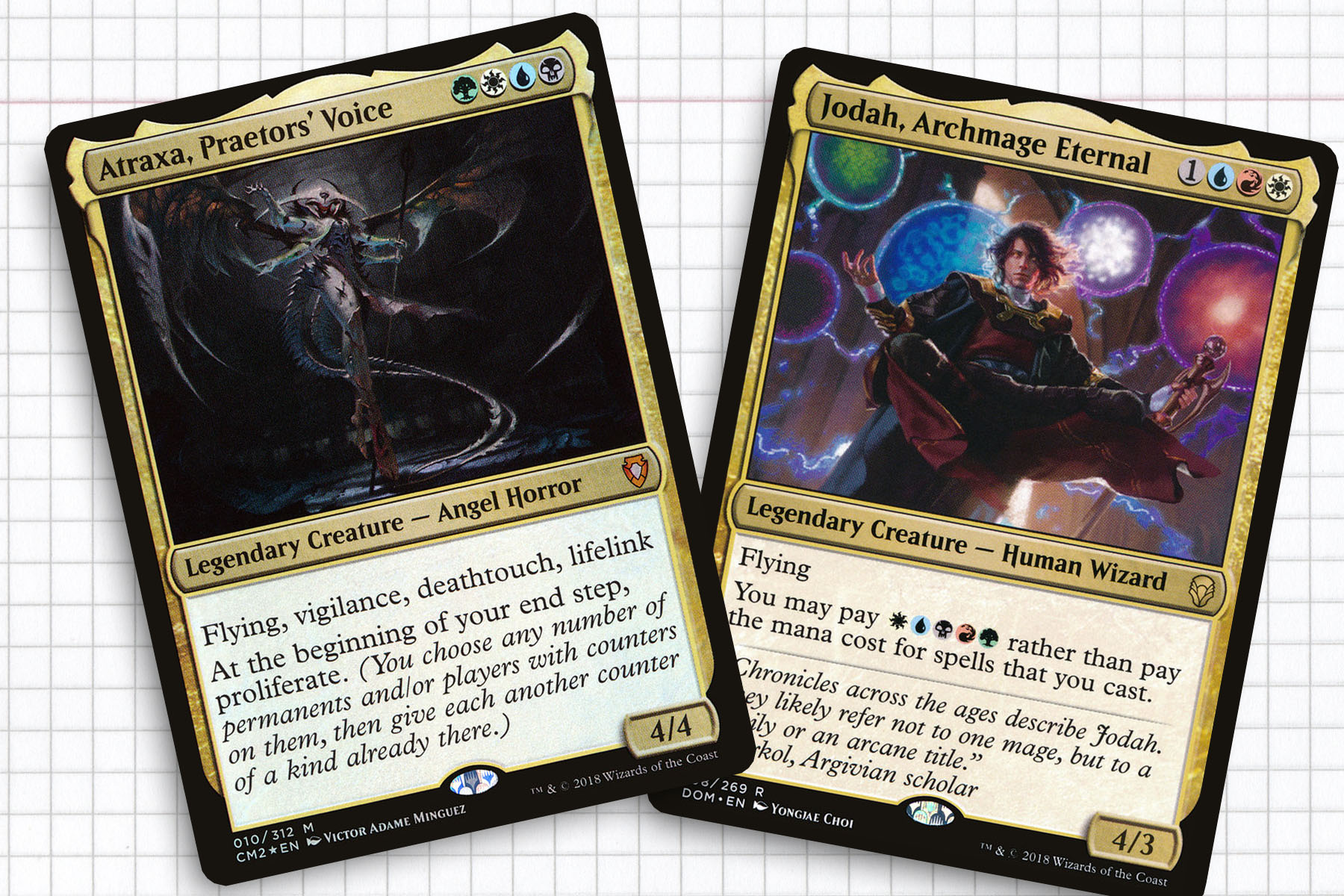
The Fine Line
We’ve reached the last five years. Now Wizards is going out of their way to design an annual product for us, given us the undercover “Commander Masters” in the form of Battlebond, and also tucking format staples away in Standard legal sets in the form of cards like Cyclonic Rift or Utter End. With this attention towards Commander, I’ve seen three issues begin to arise:
- The Commander community started complaining when a legend didn’t work well in the format.
- Wizards tried to give us what we asked for, but missed the mark.
- Commander is getting homogenized from de facto best generals.
To the first point, Commander players may have gotten a bit of big head, Dragonlord Kolaghan probably being the best example in recent memory. Yes, Kolaghan is legend whose first two lines of text are pretty inspiring for a deck builder. But sadly her third ability doesn’t work well or at all in Commander, unless Persistent Petitioners really take off. The community wants cool legends and it sucks when one of a cycle doesn’t fit into the Commander mold. But maybe it wasn’t designed for us. Or maybe just being a Dragon was the part Wizards thought we’d value most.
The second point more leans towards my hatred of being pandered to. As I said, I liked Kamigawa block because the legends were never built with Commander in mind and thus, they worked as both build arounds and unique creatures. In this current age, having Wizards constructing creatures per our requests has been nice. Still, Ulrich of the Krallenhorde and Jhoira, Weatherlight Captain came up short of being the werewolf legend and artifacts-matter Izzet legend many wanted. Communication errors can occur.
And to the last point, it’s hard to look at the list of most popular generals of all time—currently Atraxa, Praetors’ Voice, Meren of Clan Nel Toth, Breya, Etherium Shaper, Oloro, Ageless Ascetic, and Nekusar, the Mindrazer are the top five—and not think that Commander products have done some homogenizing of the format. In the playgroups I play in and the Magic Online games I participate in however, I have to admit that I don’t see these generals in Command Zone very often. The hard numbers from EDHrec can’t be debated, but results out in the wild prove that the idea of a homogenized metagame is a perception issue.
In the last year we’ve returned to both Dominaria and Ravnica, seen a lot of old and new faces, and Wizards has started designing towards their own Commander-lite format, Brawl. Legends are not going anywhere, but I would contest that their purpose has drastically changed. My favorite generals of the last year have been Jodah, Archmage Eternal and Kumena, Tyrant of Orazca, both coming out of Standard-legal product with varying degrees of linear deck-building explicit on the card. For all my personal complaints when I first see a card previewed, I hold no deep-seated complaints about where we are going with the supertype.
Thank you to all the people who made it through my written history of how legends have evolved throughout the games history. I’d love to hear your perspective on legends, Commander and Brawl as well. Thanks for any feedback and I hope to catch you next time.
Ryan Sainio is a Graphic Designer who writes about EDH, the EDH community, and streams on Twitch in his down time. He has been playing Magic: The Gathering since 7th Edition in 2002 and values flavorful and fun gameplay over competitively optimized decks. Join him for a stream at twitch.tv/hipstersainio on Tuesday nights.

